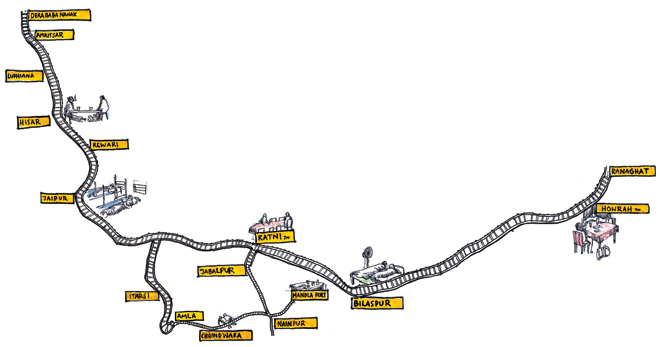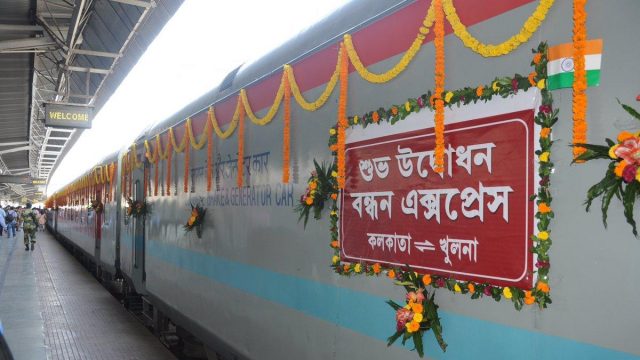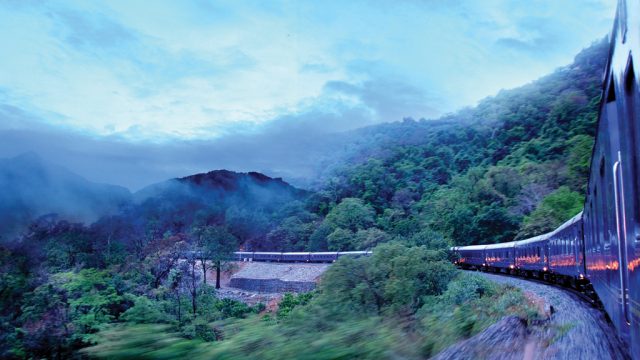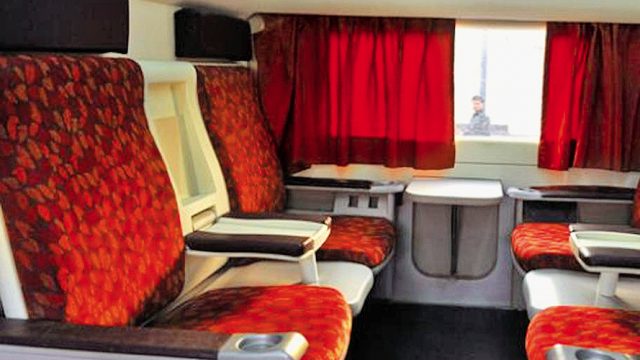Things on a map look very different from things on the ground. As the fluorescent marker wanders
“Dear me! It’s going to be bloody hot,” he sighs, smiling wanly. “We’re not going to take the usual route through UP and Bihar,” I continue, “instead, we’ll cut through Haryana, Rajasthan, Madhya Pradesh… we’ll hop trains wherever we can, damn the planning, damn the heat,” I gurgle in manic Dean Moriarty monologue. My Sal Paradise looks unconvinced. “Three thousand kilometres across India by train—unreserved, first class… Tea at small wayside stations, morning at the Golden Temple, dinner in Jabalpur—you will never do anything like this again,” I suggest.

Dera Baba Nanak to Amritsar (11.30am, 1.5hr, 50km, Passenger Train). Dera Baba Nanak—the name has the ring of a frontier town, a forgotten outpost. It’s situated on the left bank of the river Ravi, on the India-Pakistan border. The rows of eucalyptus trees that run along the railway line hide miles of paddy fields that stretch into the distance. Knots of people with bags and suitcases stand around a small cream-coloured brick building that serves as a station.
Soon the train appears as a speck on the tracks. The rhythmic clacket, thud, clacket and thud slowing to a gentle screeching halt. There’s a temporary lull in the conversations, as people clamber lazily on to the train. We start towards the train, and then slow down. There’s time enough to dawdle, and look at men disassembling a track inspection carriage. It’s not the fastest start to our longest journey, but then nobody seems to be in any hurry to leave Dera Baba Nanak.
Amritsar to Ludhiana (2.45pm, 2hr15min, 136km, Shaan-e-Punjab). The Shaan-e-Punjab leaves on time. The afternoon heat, though, makes the landscape seem even more monotonous—everyone looks bored. This is paddy fields forever, from Tangra to Philaur.
Ludhiana to Hisar (10.30pm, 7hr, 211km, Passenger Train). The general compartment of the train is packed, as usual. People lie sprawled over every inch of bench and floor. We corner some place on the footboard. Travelling by train at night is so very different from travelling during the day. Starlight and the odd naked bulb throw disparate shadows, giving the landscape an almost mysterious depth. Nameless lonely villages slip by. The movement, the constant thud, clacket, thud of wheels, slow and steady, keeps loneliness at bay. A warm breeze keeps me up as I stand clutching the bars at the compartment door. Nityan sits on the steps below me, drifting in and out of sleep. Every once in a while someone goes into the toilet, and a vile smell lingers for a few moments. When the thud, clacket, thud stops, I’ll know that we’ve arrived.

Hisar to Rewari (6.25am, 3hr30min, 143km, Passenger Train). Dawn is just about breaking. Hisar station is quite deserted. An old man, all skin and bones, is lying sprawled on the platform. His sunken eyes are closed, a tattered dhoti draped over him. He’s clutching a staff in his left hand. He lies there like a malformed idea which I’m too tired to grasp.
A single ticket counter is open. The clerk looks quite murderous. “Jaipur jana hai,” I say. “Yahan se Rewari jana padega, Jaipur ke liye 1.30pm ke pehele koyi gaadi nahin hai,” comes the reply. We’d seen a petite narrow gauge train standing like a poor second cousin on the last platform of the station. I’m tempted to run back to the platform and jump on it, but we’ve got to be at Jaipur by 7pm. At 6.25am we’re on a train to Rewari.
Rewari to Jaipur (Bus). No trains anytime soon.

Jaipur to Itarsi (7.30pm, 12hr, 795km, Jaipur-Madras Express). We’ve only ever heard of First AC. After two sleepless days stuffed in unreserved compartments we feel like poor country cousins and intruders. The beds are huge. There’s a small cabinet to hang our coats. The sliding doors of the coupe shield us from intrusion, and in another day and age the food would have been handed in through a small sliding metal grill. We sit on the edge of our seats, admiring this little utopia. And then doze off.
I wake up to a hushed conversation between Arun Mathur, the retired PWD engineer sitting opposite us, and a shifty balding paan-chewing confidante. “Sir, culvert ka contract to kisi aur ko mil gaya hai—us ke paas to engineer bhi nahin hai,” says the confidante grimly. “Kyun chinta karte ho,” says Mathurji, “Main baat kar leta hoon, ham bhi kahin se engineer pakad ke le aayenge.”
Itarsi to Chhindwara via Amla (12.10pm, 7hr, 246km, Passenger Train). The terrain has changed overnight. The dry farmlands and flats which had been with us for the last few days have been replaced by the rocky undulating terrain of the Satpura range. Short level stretches of land, studded with neem, acacia and sagol trees, give way to bends that skirt around ravines. At Betul the land turns much greener—sugarcane fields appear. We pass through a progression of small stations—the Bacchi Road station must be the most desolate in the world. One abandoned building, no platform, rocky sandbanks on either side, one old man sitting staring blankly at the passing train—the look of a man who’s happy to be where he is, but likes to see the clacketing, thudding, clacketing trains pass by, reminding him of the larger and comfortably distant outside world.

A furious dust storm envelops the train as it approaches Chhindwara. A single tree flails in the wind, branches screaming and stretching against the fury of the storm. Swirls of dust turn the hills of the Satpuras into silhouettes. Soon a driving rain pounds the earth, releasing the first smells of the monsoon. I stick my hand out of the window, cup a little of the cold water in my hands, and wash the grime of the last four days off my face.
Chhindwara to Mandla via Nainpur (11.15pm, 8hr15min, 170km, narrow-gauge Passenger Train). We’ve been looking forward to this. Finally, we can get on board the world’s most extensive narrow-gauge network, centred on Nainpur Junction in the heart of Madhya Pradesh. This network of slow trains extends from Jabalpur in the north to Nagpur in the south, and Chhindwara in the west to Mandla Fort in the east—a network of several hundred kilometres. The tracks of the narrow-gauge train are possibly a little more than two feet apart. Step to one side of the compartment and the whole train tilts. There are eight bogeys to this train—all with only sitting space.
Mandla Fort to Nainpur (9.15am, 2hr45min, 30km, Passenger Train). “Yahan kaise aana huan?” roars Top Singh Millar, the watch-out man on the narrow-gauge train from Mandla back to Nainpur, as the red dots on the speedometer climb till they indicate the maximum speed of 45kmph. We’re riding in the engine, surrounded by an impressive array of metres, levers, and wheels. Top Singh is a dashing, bandanna-sporting sardar. “Johnny Lever hain,” says Mani Ram, gesturing towards him. The engine shudders and teeters precariously—I keep banging my head against the doorway. “Bhains khadhi hai,” yells Top Singh, glancing out of one of the narrow screens that looks out on to the tracks, reflexively flicking the switch for the emergency lights (which apparently scare cattle away), and simultaneously banging down the knob for the horn. Two sharp toots ring out—and the buffalo goes scurrying off the track.
The train slows down as we approach a level crossing. “Teen lakh ka dabba khada hai,” shouts Top Singh, referring to an Indica which is waiting at the crossing. The train slows down.
A man in khaki jumps off from the guard’s cabin, runs to the gate, closes it, then waits for the train to cross, opens the gate, and runs back to the guard cabin. It’s a ritual which is repeated at each of the 20 crossings between Mandla and Nainpur. “Ek gate ka 8 anna milta hai,” says Top Singh sadly, “poorey raste ka usko 9 rupaiye. Aisa hai hamara railway.”
Nainpur to Jabalpur (3.40pm, 3hr40min, 110km, Satpura Express). Satpura Express is the fastest train on this narrow-gauge network. It goes at a top speed of 50kmph. The first-class saloon, however, is a disappointment.
The first hour of the journey takes us through dense but bare forests. The trees turn greener as we roll lazily into Jabalpur district. The dense greens of the desu trees are a relief after the parched browns. The twilight rays of the sun stream through the grills into the compartment, as we cross another tantalisingly green stream, before getting to Jabalpur.
After two days on narrow-gauge, the journey to Katni seems like a space-age miracle. Inside the train, things are unnaturally calm—some people are reading, others gossip.From where I’m standing I can see rows of perfectly aligned ceiling fans. Through the grills I see compartment after compartment of people. This is the Railways at its industrial, organised best.
Katni to Bilaspur (12.05am, 7hrs, 317km, ticketless). Three cops from Jabalpur sprawl out playing cards. At 2am one of them notices Nityan sketching. “Kya kalakari hai, aap ko to police sketch karne chahiye,” they say, passing the sketch around. “Yahan kya hai dekhne ke liye? Aap Jhabua jayiye,” says the thin one in the tattered banian. “Wahan pe to aadmi aur aurat dono Mahua peeke talli hote hain, har shaadi mein murder bhi hota hai,” he says, giving me a crash course in the criminal habits of tribals.

At the next station we’re chased off the sleeper compartment by a cop who looks like he hopped out of a spaghetti Western. We jump off and head straight to the unreserved compartment. The people here look strangely poor and malnourished. The compartment is one big mess of arms and legs. But there’s no pushing or shoving.
We find ourselves on the steps again. The night passes in a blur, and as the first light of the morning streams into the compartment, a chai seller wanders through, singing “chaaeee beegu” in lilting tones. A little later a panhandler wanders in, singing pop Hindi songs to the tune of an ektara fashioned out of a stick and a tin can. There’s something magical about the moment—a sense of community which I hadn’t felt before.
Bilaspur to Howrah (4.30pm, 10hr, 831km, Jnanalakshmi Express). There’s a monsoon coolness in the air. The train races through Orissa and into West Bengal. I’m too tired to think, to feel. I sleep. A sound deep sleep, while the clacket, thud, clacket of the wheels runs through my dreams.
Sealdah to Ranaghat (9am, 74km). The humidity of Kolkata smothers you. Banana sellers jostle with commuters to get into the ticket queue. The heat is festering.
The journey to Ranaghat is short. The station is like any other station in these parts. Dirty, humid, and mouldy. I jump across the railway lines to the adjoining platform. I sit down on a bench and take my shirt off—the grime of a week has turned it black. I leave it hanging from a board which says ‘Ranaghat’. Nityan and I look at each other and smile—it’s the end of the line. Was there a point to it? Maybe…but it’s the rhythmic clacket, thud, clacket which carried us. Meaning, if it appeared, was incidental. So in Ranaghat as the afternoon sun rises I think of Dean Moriarty. I think only of Dean Moriarty. As we start towards the exit, I’ve got to remind myself not to head to the ticket counter.
Train journey
Leave a Reply
You must be logged in to post a comment.





